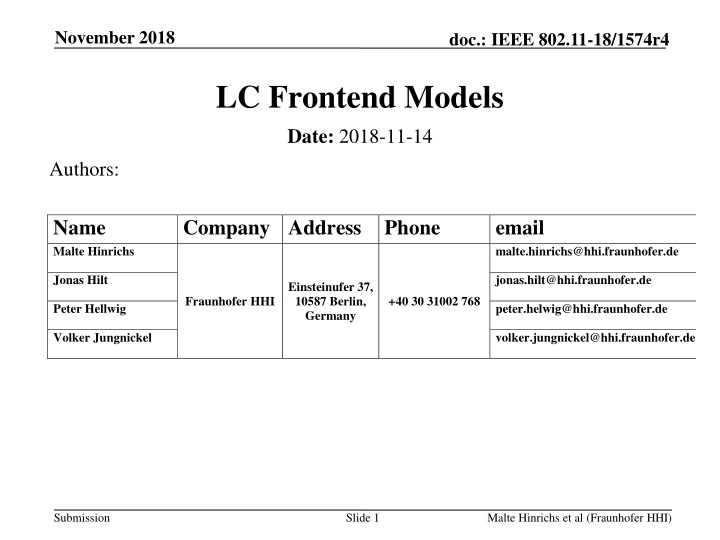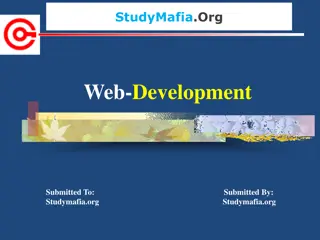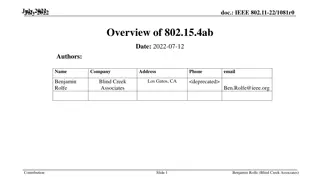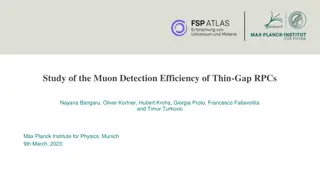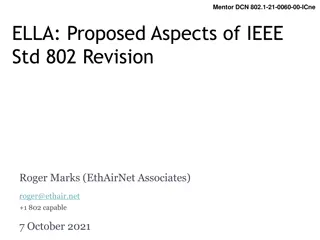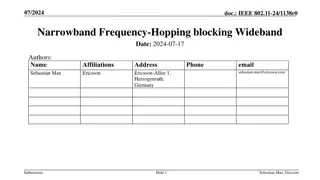Proposed Wideband LC Tx and Rx Frontend Models for IEEE 802.11-18/1574r4
Document from November 2018 by Malte Hinrichs and team at Fraunhofer HHI proposing wideband LC Tx and Rx frontend models for channel modeling work of TG 11bb in IEEE 802.11 standard. The document includes detailed descriptions of the frontend models, driver electronics, LED/laser diode configurations, response measurements, and filter model generation steps.
Download Presentation

Please find below an Image/Link to download the presentation.
The content on the website is provided AS IS for your information and personal use only. It may not be sold, licensed, or shared on other websites without obtaining consent from the author.If you encounter any issues during the download, it is possible that the publisher has removed the file from their server.
You are allowed to download the files provided on this website for personal or commercial use, subject to the condition that they are used lawfully. All files are the property of their respective owners.
The content on the website is provided AS IS for your information and personal use only. It may not be sold, licensed, or shared on other websites without obtaining consent from the author.
E N D
Presentation Transcript
November 2018 doc.: IEEE 802.11-18/1574r4 LC Frontend Models Date: 2018-11-14 Authors: Name Malte Hinrichs Company Address Phone email malte.hinrichs@hhi.fraunhofer.de Jonas Hilt jonas.hilt@hhi.fraunhofer.de Einsteinufer 37, 10587 Berlin, Germany Fraunhofer HHI +40 30 31002 768 Peter Hellwig peter.helwig@hhi.fraunhofer.de Volker Jungnickel volker.jungnickel@hhi.fraunhofer.de Submission Slide 1 Malte Hinrichs et al (Fraunhofer HHI)
November 2018 doc.: IEEE 802.11-18/1574r4 Background To support the channel modeling work of TG 11bb, this document proposes wideband LC Tx and Rx frontend models based on real measurements. Submission Slide 2 Malte Hinrichs et al (Fraunhofer HHI)
November 2018 doc.: IEEE 802.11-18/1574r4 LC Tx frontend LC Tx comprises sophisticated driver electronics and LED/laser diode. Tx DSP driver Tx DSP has single-ended or differential 50 interface to the driver Driver does impedance matching (from 50 to few at LED) Aims at wide bandwidth through sophisticated circuit design Bandwidth of high-power LEDs is limited by large area of active zone, radiative/non-radiative recombination effects play a minor role Driver is custom-designed for each LED (e.g. infrared, visible) Modulation and bias currents can be changed in the driver Modulation current has an impact on the reach of the LC link Submission Slide 3 Malte Hinrichs et al (Fraunhofer HHI)
November 2018 doc.: IEEE 802.11-18/1574r4 LC Tx frontend response Measured with vector network analyzer from DC to 300 MHz using Rx with multiple GHz BW LED: CREE XPE RED-L1-R2_N3 Amplitude and phase response Observations: High-pass ~100 kHz Little more gain up to 10 MHz Almost flat response with little ripple until 240 MHz Steep low-pass thereafter Submission Slide 4 Malte Hinrichs et al (Fraunhofer HHI)
November 2018 doc.: IEEE 802.11-18/1574r4 LC Tx frontend model Nthorder low-pass 1storder high-pass e/o V VGA + G bias Variable gain [V/A] amplifier to set RMS modulation current [A] Nth order low-pass with variable cut-off e.g. fg = 20, 100, 200 MHz May be matched to the highest Tx signal bandwidth High-pass fg = 100 kHz may cause baseline wander effects! Added constant bias current [A] e/o converter with infinite BW and conversion efficiency Tx [W/A] Any non-linear effects are ignored for now, may be included later Submission Slide 5 Malte Hinrichs et al (Fraunhofer HHI)
November 2018 doc.: IEEE 802.11-18/1574r4 Tx filter model generation Steps (see MATLAB code on the right): Generate Butterworth highpass IIR filter n = 1, fc= 100 kHz, fbw= 1 GHz Generate Butterworth lowpass IIR filter n = 13, fc= 237 MHz, fbw= 1 GHz Transform Butterworth filters to second- order sections form Combine highpass and lowpass filters f_bw = 1e9; % Reference bandwidth (Hz) %% Highpass filter n_hi = 1; % Filter order % Highpass cut-off frequency (Hz) f_c_hi = 1e5; [z_hi, p_hi, k_hi] = ... butter(n_hi, f_c_hi/f_bw, 'high'); [sos_hi, g_hi] = ... zp2sos(z_hi, p_hi, k_hi); %% Lowpass filter n_lo = 13; % Filter order % Lowpass cut-off frequency (Hz) f_c_lo = 2.37e8; [z_lo, p_lo, k_lo] = ... butter(n_lo, f_c_lo/f_bw); [sos_lo, g_lo] = ... zp2sos(z_lo, p_lo, k_lo); Output: sos: Second-order sections parameter matrix (see next slide) g: Gain factor (see next slide) H: Matlab filter object %% Combined bandpass filter passband_gain = -23.17; % Passb. gain (dB) sos = [sos_hi; sos_lo]; g = g_hi*g_lo*10^(passband_gain/20); H = dfilt.df2sos(sos, g); Submission Slide 6 Malte Hinrichs et al (Fraunhofer HHI)
November 2018 doc.: IEEE 802.11-18/1574r4 Tx filter parameters Parameter matrix sos: k b0 1 1 2 1 3 1 4 1 5 1 6 1 7 1 8 1 b1 b2 1 a1 a2 -1 0 0 1 1 1 1 1 1 1 1 1 1 1 1 1 1 -0,999685890072330 0,000000000000000 -0,438344960151427 0,000000000000000 -0,887102175721872 0,206305166337290 -0,919219818954179 0,249979593051648 -0,975816547084403 0,326941331405787 -1,061972527809740 0,444098528743552 -1,185825678654060 0,612517342065797 -1,359712686983980 0,848973527438837 1 2 2 2 2 2 2 Gain factor g: 1,40738795875631E-08 Submission Slide 7 Malte Hinrichs et al (Fraunhofer HHI)
November 2018 doc.: IEEE 802.11-18/1574r4 Tx filter graphical representation Submission Slide 8 Malte Hinrichs et al (Fraunhofer HHI)
November 2018 doc.: IEEE 802.11-18/1574r4 LC Rx frontend LC Rx comprises of PD + sophisticated transimpedance amplifier (TIA). Bootstrap TIA Rx DSP TIA does the impedance matching (from M s at PD to 50 ) Bandwidth limitation of PDs comes from large area mostly TIA aims at wider bandwidth through sophisticated bootstrap design Compensates the capacitance of large-area PD at the cost of more noise Bootstrap TIA is custom-designed for a given PD TIA has single-ended or differential 50 interface to the Tx DSP Submission Slide 9 Malte Hinrichs et al (Fraunhofer HHI)
November 2018 doc.: IEEE 802.11-18/1574r4 LC Rx frontend response Measured with vector network analyzer from DC to 300 MHz using laser with several GHz BW Amplitude and phase responses Observations: Higher pass ~ few 100 kHz blocks DC, modulated ambient light Almost flat response with little ripple until 250 MHz Higher order low-pass thereafter Submission Slide 10 Malte Hinrichs et al (Fraunhofer HHI)
November 2018 doc.: IEEE 802.11-18/1574r4 LC Rx frontend model 1storder high-pass 1thorder low-pass o/e + + V AGC G shot noise thermal noise o/e converter for PD with infinite BW and conversion efficiency Rx [A/W] For PD, ignore the shot noise, while it is to be added directly after APD Add AWGN for shot noise RMS ithermal [A] after the APD High-pass filter fg = 100 kHz Add AWGN for thermal noise RMS ithermal [A] before the TIA AGC [V/A] to compensate overall attenuation in Tx + channel + Rx Low-pass with variable cut-off frequency e.g. fg = 20, 100, 200 MHz Could be matched to the required Rx signal bandwidth Submission Slide 11 Malte Hinrichs et al (Fraunhofer HHI)
November 2018 doc.: IEEE 802.11-18/1574r4 Rx filter model generation Steps (see MATLAB code on the right): Generate Butterworth highpass IIR filter n = 1, fc= 100 kHz, fbw= 1 GHz Generate Butterworth lowpass IIR filter n = 6, fc= 258 MHz, fbw= 1 GHz Transform Butterworth filters to second- order sections form Combine highpass and lowpass filters f_bw = 1e9; % Reference bandwidth (Hz) %% Highpass filter n_hi = 1; % Filter order % Highpass cut-off frequency (Hz) f_c_hi = 1e5; [z_hi, p_hi, k_hi] = ... butter(n_hi, f_c_hi/f_bw, 'high'); [sos_hi, g_hi] = ... zp2sos(z_hi, p_hi, k_hi); %% Lowpass filter n_lo = 6; % Filter order % Lowpass cut-off frequency (Hz) f_c_lo = 2.58e8; [z_lo, p_lo, k_lo] = ... butter(n_lo, f_c_lo/f_bw); [sos_lo, g_lo] = ... zp2sos(z_lo, p_lo, k_lo); Output: sos: Second-order sections parameter matrix (see next slide) g: Gain factor (see next slide) H: Matlab filter object %% Combined bandpass filter passband_gain = 6.8; % Passb. gain (dB) sos = [sos_hi; sos_lo]; g = g_hi*g_lo*10^(passband_gain/20); H = dfilt.df2sos(sos, g); Submission Slide 12 Malte Hinrichs et al (Fraunhofer HHI)
November 2018 doc.: IEEE 802.11-18/1574r4 Rx filter parameters Parameter matrix sos: k b0k 1 1 2 1 3 1 4 1 b1k b2k 1 a1k a2k -1 0 1 1 1 1 1 1 1 -0,999685890072330 0,000000000000000 -0,810740644092165 0,176497458365327 -0,911280817294377 0,322395236030663 -1,160559924501940 0,684133898314801 2 2 2 Gain factor g: 0,00269082217204371 Submission Slide 13 Malte Hinrichs et al (Fraunhofer HHI)
November 2018 doc.: IEEE 802.11-18/1574r4 Rx filter graphical representation Submission Slide 14 Malte Hinrichs et al (Fraunhofer HHI)
November 2018 doc.: IEEE 802.11-18/1574r4 Summary Realistic models for LC frontends Tx and Rx have been proposed Models include major optical frontend effects considered relevant for evaluating the performance of physical layer proposals in TGbb It has been shown how to simulate LC frontends in Matlab using standard filters for Tx and Rx Parametrization of filters matches to measurements on real LC frontends, manufactured in our lab. Check the appendix and reference for more details Submission Slide 15 Malte Hinrichs et al (Fraunhofer HHI)
<month year> November 2018 doc.: IEEE 802.11-18/1574r4 Appendix: Filter model structure Serial cascade of biquadratic IIR filters ( Second-order sections ) Transfer function (per section): Implementation (e.g. Direct form 2): Transfer function (? sections): , ?: gain factor See: https://en.wikipedia.org/wiki/Digital_biquad_filter, https://de.mathworks.com/help/signal/ref/zp2sos.html Submission Slide 16 Malte Hinrichs et al (Fraunhofer HHI) <author>, <company>
November 2018 doc.: IEEE 802.11-18/1574r4 Further reading L. Grobe, V. Jungnickel, K. Langer, M. Haardt and M. Wolf, "On the impact of highpass filtering when using PAM-FDE for visible light communication," 2016 IEEE Wireless Communications and Networking Conference Workshops (WCNCW), Doha, 2016, pp. 239-245. Submission Slide 17 Malte Hinrichs et al (Fraunhofer HHI)
